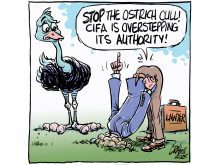WHILE it might not be as obvious as a trade barrier or as frightening as bioterrorism, fusarium headblight is a serious threat to prairie agriculture.
For some time it has been known that by downgrading wheat and barley, fusarium costs prairie grain growers tens of millions of dollars a year.
But a report from the George Morris Centre on the relative profitability of hog production in Western Canada and the United States Midwest has exposed the disease as a far larger economic menace.
The Guelph, Ont.,-based think-tank’s report drives home that fusarium is a major impediment to expansion of hog feeding in the West, the industry that many hope will save rural economies.
Read Also

Budget seen as fairly solid, but worrying cracks appear
The reaction from the agriculture industry to prime minister Mark Carney’s first budget handed down November 4th has been largely positive.
When fusarium’s impediment to the hog industry is factored in, the cost of the disease in Western Canada amounts to hundreds of millions of dollars annually.
The centre’s report says the West’s claim to the lowest hog production costs in North America is shifting to southern Minnesota. There are two key reasons: American subsidies that promote corn production and drive down its price and, in Canada, fusarium that reduces the amount of feed grain available to hog feeders.
Ironically Canada has a greater chance of changing Mother Nature than American subsidies.
A quick and effective scientific solution to the disease is needed because every passing year without one has a huge cost.
The George Morris Centre report estimates fusarium adds $3.27 per head to the cost of raising pigs in the eastern Prairies.
That cost, and the attraction of cheap corn in the Midwest, has encouraged as many as 2.4 million head of Manitoba weanlings to be shipped to the U.S. for feeding in 2001.
Manitoba Agriculture estimates keeping those weanlings in the province would require 165 more feeder barns.
Without them, rural communities are robbed of thousands of jobs and millions of dollars in economic spinoffs.
And if slaughtered and processed at home, the hogs would generate yet more jobs at packing plants and in the trucking industry.
All told, those hogs could generate an estimated $300 to $600 million in economic activity in Manitoba alone.
But fusarium is spreading west. If not stopped, it will have a similar impact on Saskatchewan and Alberta’s hog industries.
There are many challenges facing western farmers but few have the economic impact of fusarium. The research effort to breed resistant varieties and develop chemical and biological control has begun.
But more resources – from government, industry, grain farmers and livestock producers – must be allocated to the fight.
Rarely will a dollar invested in research have such a rewarding payback.














